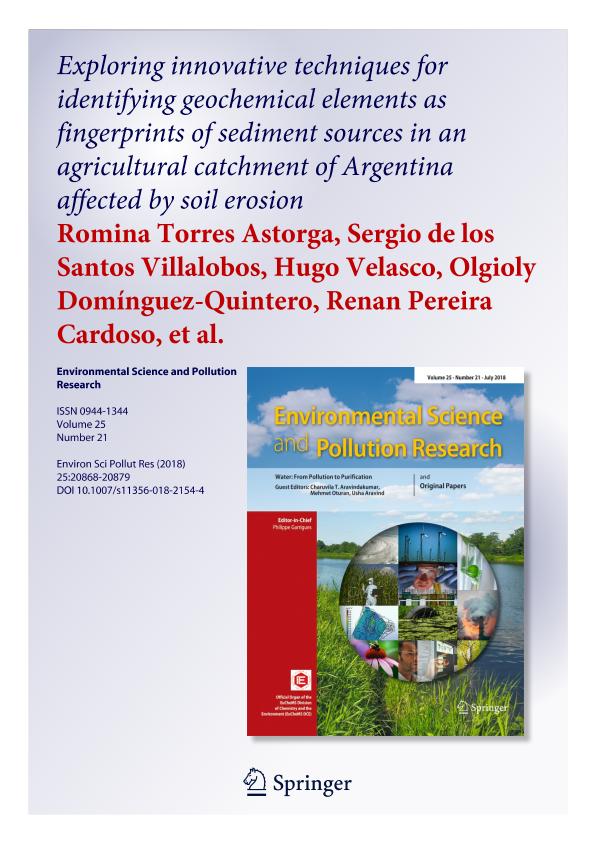Mostrar el registro sencillo del ítem
dc.contributor.author
Torres Astorga, Romina Vanesa

dc.contributor.author
de los Santos Villalobos, Sergio
dc.contributor.author
Velasco, Ricardo Hugo

dc.contributor.author
Domínguez Quintero, Olgioly
dc.contributor.author
Pereira Cardoso, Renan
dc.contributor.author
Meigikos Dos Anjos, Roberto

dc.contributor.author
Diawara, Yacouba
dc.contributor.author
Dercon, Gerd
dc.contributor.author
Mabit, Lionel
dc.date.available
2020-02-01T01:59:14Z
dc.date.issued
2018-07
dc.identifier.citation
Torres Astorga, Romina Vanesa; de los Santos Villalobos, Sergio; Velasco, Ricardo Hugo; Domínguez Quintero, Olgioly; Pereira Cardoso, Renan; et al.; Exploring innovative techniques for identifying geochemical elements as fingerprints of sediment sources in an agricultural catchment of Argentina affected by soil erosion; Springer Heidelberg; Environmental Science and Pollution Research; 25; 21; 7-2018; 20868-20879
dc.identifier.issn
0944-1344
dc.identifier.uri
http://hdl.handle.net/11336/96462
dc.description.abstract
Identification of hot spots of land degradation is strongly related with the selection of soil tracers for sediment pathways. This research proposes the complementary and integrated application of two analytical techniques to select the most suitable fingerprint tracers for identifying the main sources of sediments in an agricultural catchment located in Central Argentina with erosive loess soils. Diffuse reflectance Fourier transformed in the mid-infrared range (DRIFT-MIR) spectroscopy and energy-dispersive X-ray fluorescence (EDXRF) were used for a suitable fingerprint selection. For using DRIFT-MIR spectroscopy as fingerprinting technique, calibration through quantitative parameters is needed to link and correlate DRIFT-MIR spectra with soil tracers. EDXRF was used in this context for determining the concentrations of geochemical elements in soil samples. The selected tracers were confirmed using two artificial mixtures composed of known proportions of soil collected in different sites with distinctive soil uses. These fingerprint elements were used as parameters to build a predictive model with the whole set of DRIFT-MIR spectra. Fingerprint elements such as phosphorus, iron, calcium, barium, and titanium were identified for obtaining a suitable reconstruction of the source proportions in the artificial mixtures. Mid-infrared spectra produced successful prediction models (R2 = 0.91) for Fe content and moderate useful prediction (R2 = 0.72) for Ti content. For Ca, P, and Ba, the R2 were 0.44, 0.58, and 0.59 respectively.
dc.format
application/pdf
dc.language.iso
eng
dc.publisher
Springer Heidelberg

dc.rights
info:eu-repo/semantics/openAccess
dc.rights.uri
https://creativecommons.org/licenses/by-nc-sa/2.5/ar/
dc.subject
ARTIFICIAL MIXTURES
dc.subject
DIFFUSE REFLECTANCE FOURIER TRANSFORMED MID-INFRARED (DRIFT-MIR) SPECTROSCOPY
dc.subject
ENERGY-DISPERSIVE X-RAY FLUORESCENCE (EDXRF) SPECTROSCOPY
dc.subject
FINGERPRINTS
dc.subject.classification
Otras Ciencias de la Tierra y relacionadas con el Medio Ambiente

dc.subject.classification
Ciencias de la Tierra y relacionadas con el Medio Ambiente

dc.subject.classification
CIENCIAS NATURALES Y EXACTAS

dc.title
Exploring innovative techniques for identifying geochemical elements as fingerprints of sediment sources in an agricultural catchment of Argentina affected by soil erosion
dc.type
info:eu-repo/semantics/article
dc.type
info:ar-repo/semantics/artículo
dc.type
info:eu-repo/semantics/publishedVersion
dc.date.updated
2020-01-30T21:59:06Z
dc.journal.volume
25
dc.journal.number
21
dc.journal.pagination
20868-20879
dc.journal.pais
Alemania

dc.journal.ciudad
Heidelberg
dc.description.fil
Fil: Torres Astorga, Romina Vanesa. Consejo Nacional de Investigaciones Científicas y Técnicas. Centro Científico Tecnológico Conicet - San Luis. Instituto de Matemática Aplicada de San Luis "Prof. Ezio Marchi". Universidad Nacional de San Luis. Facultad de Ciencias Físico, Matemáticas y Naturales. Instituto de Matemática Aplicada de San Luis "Prof. Ezio Marchi"; Argentina
dc.description.fil
Fil: de los Santos Villalobos, Sergio. Universidad de Sonora; México. Consejo Nacional de Ciencia y Tecnología; México
dc.description.fil
Fil: Velasco, Ricardo Hugo. Consejo Nacional de Investigaciones Científicas y Técnicas. Centro Científico Tecnológico Conicet - San Luis. Instituto de Matemática Aplicada de San Luis "Prof. Ezio Marchi". Universidad Nacional de San Luis. Facultad de Ciencias Físico, Matemáticas y Naturales. Instituto de Matemática Aplicada de San Luis "Prof. Ezio Marchi"; Argentina
dc.description.fil
Fil: Domínguez Quintero, Olgioly. Universidade Federal Fluminense; Brasil
dc.description.fil
Fil: Pereira Cardoso, Renan. Universidade Federal Fluminense; Brasil
dc.description.fil
Fil: Meigikos Dos Anjos, Roberto. Universidade Federal Fluminense; Brasil
dc.description.fil
Fil: Diawara, Yacouba. United States Department of Energy; Estados Unidos
dc.description.fil
Fil: Dercon, Gerd. International Atomic Energy Agency; Austria. Comisión Nacional de Energía Atómica; Argentina
dc.description.fil
Fil: Mabit, Lionel. International Atomic Energy Agency; Austria
dc.journal.title
Environmental Science and Pollution Research

dc.relation.alternativeid
info:eu-repo/semantics/altIdentifier/url/http://link.springer.com/10.1007/s11356-018-2154-4
dc.relation.alternativeid
info:eu-repo/semantics/altIdentifier/doi/http://dx.doi.org/10.1007/s11356-018-2154-4
Archivos asociados
